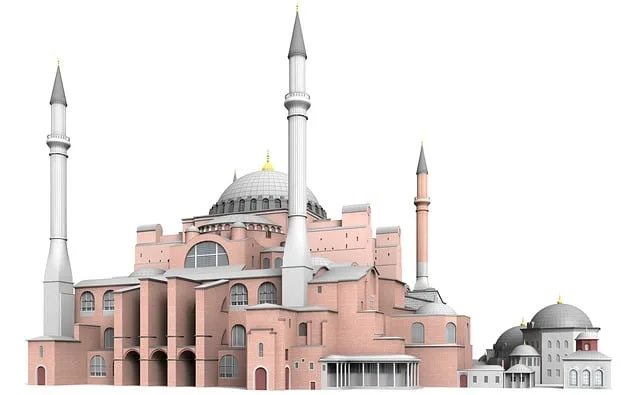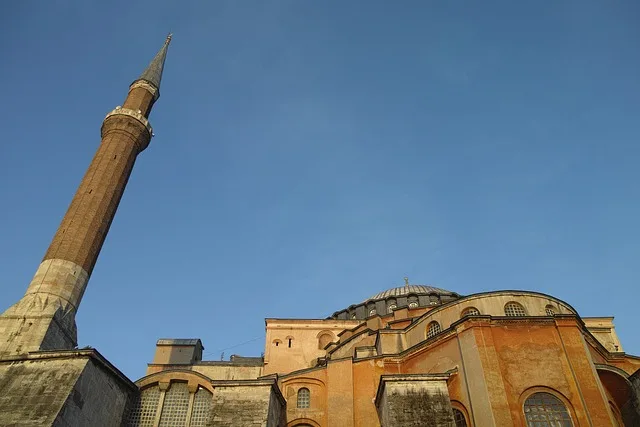Imagine walking through its grand arches, where every corner whispers tales of history. The intricate mosaics and soaring domes create an atmosphere that feels almost otherworldly. It’s like stepping into a time machine, where the past and present collide in a beautiful dance. The call to prayer echoes through its vast halls, reminding visitors of its current role as a mosque and its deep-rooted significance in the Islamic world.
But what makes the Masjid Hagia Sophia truly special is how it embodies the spirit of coexistence. It stands as a testament to the rich tapestry of cultures that have influenced it over the centuries. Just think about it: a place that has welcomed people from all walks of life, regardless of their beliefs. It’s a reminder that beauty can emerge from diversity, much like a vibrant mosaic made up of different pieces.

As you explore this architectural marvel, you can’t help but feel a sense of awe. The Masjid Hagia Sophia isn’t just a building; it’s a living symbol of Islamic heritage, a bridge connecting the past to the present. It invites you to reflect on the stories it holds and the legacy it continues to inspire. Isn’t it amazing how one structure can encapsulate so much history and meaning?
Hagia Sophia: Bridging Cultures and Faiths in the Heart of Istanbul
As you gaze up at the stunning dome, it feels like you’re peering into the heavens. The intricate mosaics, shimmering in the light, depict scenes that bridge the gap between Christianity and Islam. It’s as if the walls themselves are inviting you to explore the shared stories of these two great faiths. Can you feel the energy? It’s a place where cultures collide and coexist, reminding us that despite our differences, we all seek beauty and meaning.
Walking through Hagia Sophia is like flipping through a history book, where each page reveals a new chapter. The blend of Byzantine and Ottoman architecture is a visual feast, showcasing how different cultures can harmonize. The calligraphy and the Christian iconography dance together, creating a dialogue that transcends time. It’s a powerful reminder that our world is a mosaic of beliefs and traditions, each piece adding depth to the human experience.
From Cathedral to Mosque: The Transformative Journey of Hagia Sophia
But then, in 1453, everything changed. The Ottomans swept in, and Hagia Sophia underwent a remarkable metamorphosis. It was no longer just a cathedral; it became a mosque, adorned with minarets that reached for the sky. The transformation was not just physical; it was a cultural shift that blended two worlds. Imagine the vibrant call to prayer replacing the church bells, the intricate Islamic calligraphy dancing alongside the remnants of Christian art. It’s like watching a beautiful tapestry being woven, each thread representing a different era, a different belief.
As centuries rolled on, Hagia Sophia continued to evolve. In 1935, it opened its doors as a museum, inviting people from all walks of life to marvel at its beauty. This journey from cathedral to mosque and back to a museum is a testament to the resilience of history. It’s a reminder that places can hold multiple identities, just like people. Isn’t it fascinating how a single structure can encapsulate the essence of different cultures and religions? Hagia Sophia stands as a symbol of unity in diversity, a place where the past and present coexist in harmony, inviting us all to reflect on our shared human experience.
Hagia Sophia: A Testament to Islamic Art and Architecture Through the Ages
When you step inside, the sheer scale of the dome takes your breath away. It’s as if the heavens have opened up just for you. The intricate patterns and vibrant colors of the tiles tell stories of devotion and artistry, each piece meticulously crafted to reflect the divine. Have you ever wondered how a structure can embody both Christian and Islamic influences? Hagia Sophia does just that, showcasing a harmonious blend that speaks to the city’s rich history.

The minarets that rise majestically against the skyline are more than just architectural features; they symbolize the transition of Hagia Sophia from a cathedral to a mosque. Each minaret tells a story of faith, echoing the call to prayer that resonates through the bustling streets of Istanbul. It’s a reminder of how art and architecture can transcend time, adapting to the needs of different cultures while retaining their original beauty.
As you explore the vast nave, the interplay of light and shadow creates a mesmerizing atmosphere. It’s like stepping into a painting where every brushstroke has a purpose. The calligraphic inscriptions that adorn the walls are not just decorative; they invite contemplation, urging visitors to reflect on the deeper meanings of faith and existence.
Exploring the Spiritual Significance of Masjid Hagia Sophia in Modern Times
Imagine walking through its grand arches, where centuries of prayers have echoed off the walls. The atmosphere is thick with reverence, inviting you to reflect on your own beliefs. For many, the Hagia Sophia represents a place of connection—not just to God, but to the diverse tapestry of humanity. It’s like a spiritual crossroads, where the past meets the present, and where different faiths can find common ground.
In today’s world, where division often seems to overshadow unity, the Masjid Hagia Sophia serves as a reminder of the beauty in diversity. It invites us to explore our own spirituality while respecting the beliefs of others. Just as a river flows through various landscapes, adapting and enriching each one, the Hagia Sophia flows through time, adapting to the needs of its community while retaining its core essence.
Have you ever considered how a place can hold so much significance? The Hagia Sophia does just that. It’s a canvas painted with the stories of countless souls who have sought solace within its walls. Whether you’re a believer or simply a curious traveler, the spiritual significance of this majestic mosque is undeniable. It beckons you to pause, reflect, and perhaps even find a piece of yourself in its storied past.
Frequently Asked Questions
Are there any visitor guidelines for exploring Masjid Hagia Sophia?
Visitors to Masjid Hagia Sophia are expected to dress modestly, covering shoulders and knees. Photography is allowed, but respect for worshippers and the sacred space is essential. Silence is encouraged during prayer times, and visitors should be mindful of the ongoing religious practices. Entry may be subject to security checks.
What is the historical significance of Masjid Hagia Sophia?
Masjid Hagia Sophia, originally built as a cathedral, holds immense historical significance as a symbol of architectural innovation and cultural exchange. It reflects the Byzantine Empire’s grandeur and later served as a mosque after the Ottoman conquest. Today, it stands as a UNESCO World Heritage site, representing the intersection of Christianity and Islam, and showcasing the evolution of religious and artistic expression over centuries.
What architectural features make Hagia Sophia unique?
Hagia Sophia is renowned for its massive dome, which appears to float above the central nave, creating an awe-inspiring interior space. Its innovative use of pendentives allows for the transition from a square base to a circular dome. The building also features intricate mosaics, a rich blend of Christian and Islamic art, and a harmonious balance of light and space, making it a masterpiece of Byzantine architecture.
What role does Hagia Sophia play in Islamic culture today?
Hagia Sophia serves as a significant symbol of Islamic heritage and culture today. It functions as a mosque, reflecting its importance in contemporary Islamic worship and community life. The site embodies a blend of historical and religious significance, attracting both worshippers and tourists, and represents the rich cultural dialogue between Christianity and Islam throughout history.
How did Hagia Sophia transition from a cathedral to a mosque?
The structure originally served as a cathedral for nearly 1,000 years before being converted into a mosque in 1453 after the Ottoman conquest of Constantinople. This transition involved the addition of Islamic architectural elements, such as minarets and a mihrab, while preserving its Christian mosaics. In 1935, it was secularized and turned into a museum, but in 2020, it was reconverted into a mosque.

